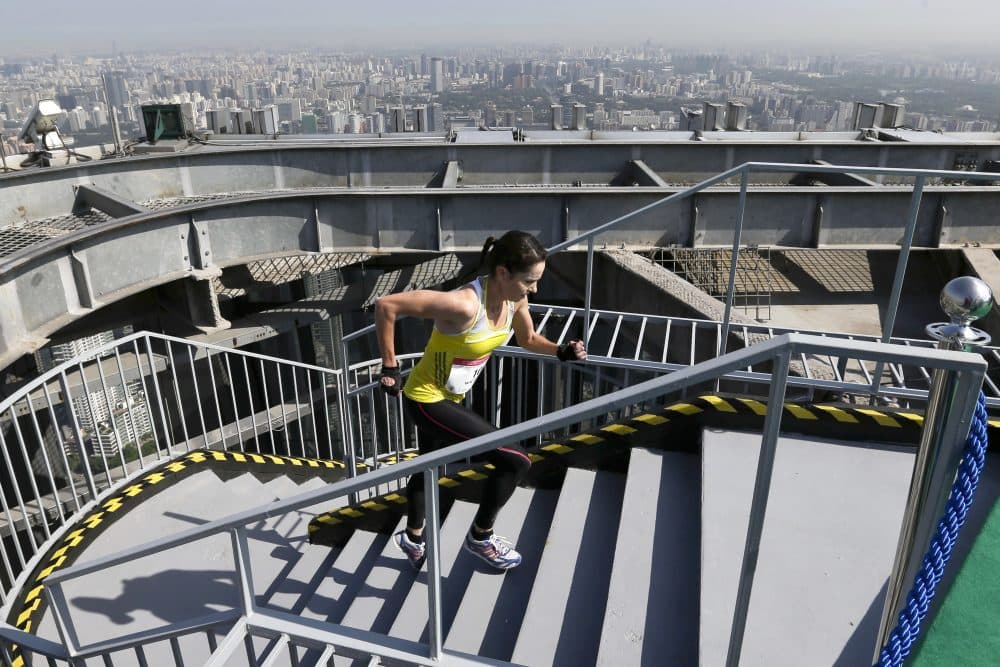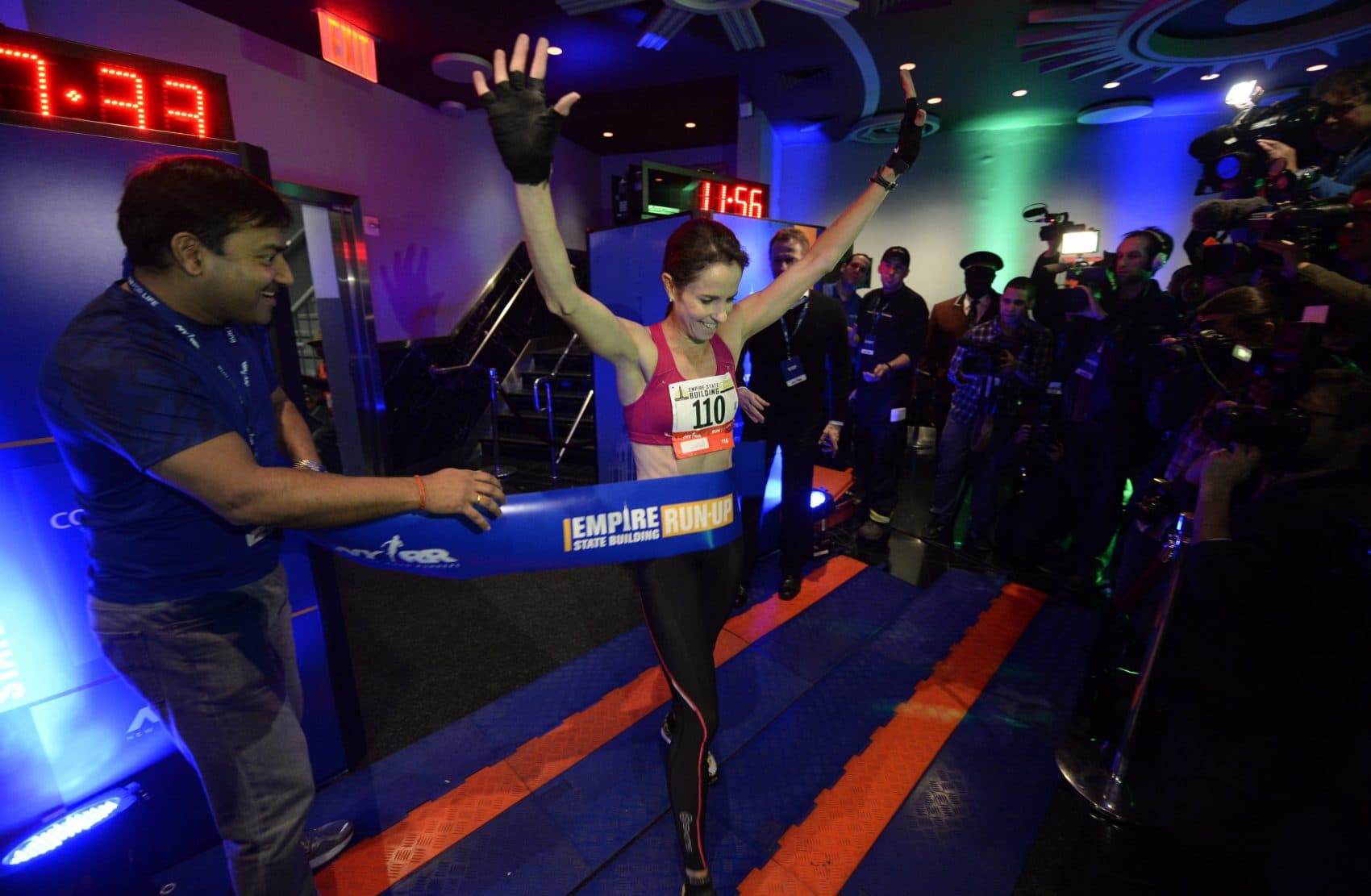Advertisement
Suzy Walsham Climbs To No. 1 After Switch From Track To Stairwells
Resume
"You’re in a quite enclosed area, so it can get a little bit stuffy," Suzy Walsham says.
Suzy spends a lot of time in stairwells. She’s kind of an expert.
"It’s not always super clean. The air’s not always nice and fresh."
'Injury Prone'
Suzy's story actually starts outdoors, on a track. She grew up in Australia and began running at age 6. At age 15, she made the World Junior Championships. But even with all this success, she had a problem.
"I was quite injury prone," Suzy says. "I had a lot of stress fractures. So I’ve had 14 stress fractures and one broken foot."
Suzy took a break for a few years, but she wasn’t ready to give up running for good. And in 2006, she achieved a life goal of representing Australia in a major international competition, the Commonwealth Games.
But that old problem kept reappearing. While training for the Commonwealth Games, Suzy noticed pain below her left knee. She put off treatment until after the competition.
"So then I went and had an MRI, and it showed the bone was cracked a third of the way through," Suzy says. "The doctor's, like, 'Whoa, we weren’t expecting that.' But he sort of said, 'This is really interesting. Do you mind if I keep this scan to show to my students? Because we don’t see injuries like this every day.' So that was the last stress fracture I had."
Vertical Racing, Stair Running
Suzy stopped running competitively. She was in her early 30s and decided to focus on her career. She’s an accountant, and she moved to Singapore for her job.
"I saw an advertisement for this vertical race in Singapore," she says.
And this is where the stairs come in, because vertical races take place in the stairwells of skyscrapers.

"And first prize was a trip to New York to come and do the Empire State Building run," Suzy says. "I kind of thought, 'Oh, I haven't been to New York for 15 years, it’s like a holiday. Yeah, I have to do a race, but let’s not worry about that. Let’s go on a holiday.'
"At that point, I only lived in a 17-story building, and I was living on the fifth floor, so I could only train between the fifth and the 17th. So I was doing 12 flights at a time."
This race was 73 floors — and Suzy wasn’t quite ready for that.
"I remember the last 30 floors were really, really super tough," she says. "And all I was thinking about was, 'New York, New York. Keep going. You've got to go to New York.' "
Not only did she keep going, she smashed the record in the process. And winning meant she got that free trip to New York to run up the Empire State Building.
"When you actually see the building in person, it looks like it's a mile. You know, it looks so tall," she says. "And I really had no expectation of how I would go. And I won, which surprised me a lot."
In some ways, vertical running is harder than regular track: your heart rate is higher, and you get more lactic acid buildup. But there’s one huge advantage — the key advantage, really.
"When you're running on the flat, you’re usually landing two to three times your body weight flat on the ground," Suzy says. "So there’s a lot of impact going through your body."
But with vertical running, it’s different.
"When you’re landing, you’re not landing with your full force of your body," she says. "So, there’s much, much less impact."
And for someone with a history of running injuries, this was a godsend.
"My body didn’t then have to deal with the bone injuries and the stress fractures that I was getting," Suzy says. "So I could basically train all the time."
"When you’re landing, you’re not landing with your full force of your body. So, there’s much, much less impact."
Suzy Walsham
'My Race Is Over'
And so, without planning on it, Suzy found a way to prolong her competitive career by becoming a champion vertical runner. The sport is low impact, but that doesn’t mean it’s no impact. There is one particular Empire State run that stands out.
"The 2009 one was a tough one," Suzy says. "I was thrown off balance just straight after the gun by the girl standing next to me. And I slammed into the wall, smashed up my face, smashed up my knee and crumpled to the floor.
"My lip puffed up. I was getting married six weeks later, and I just remember thinking, 'Oh, no, I’ve broken my nose. I’ve got all this terrible bruising.'
"My first thought was, 'My race is over. That’s it. It’s done.' And the next thing I know, someone has picked me up and pushed me through into the stairwell. So I spent the first two or three floors trying to run my tongue through my mouth, checking if I still had teeth. 'Cause I remember thinking, 'Well, if I’ve lost my teeth, I’m going to have to come back down at the end and try and find them, so I better remember where I think I’ve lost them.' But I thought, 'I’m in the stairwell now. Let’s keep going for a bit and see how we go.' "
Fellow competitors described hearing her sobs grow louder as Suzy ran closer to overtake them.
"Kept going, kept going. And then I caught the leader probably around the 65th, 66th floor," Suzy remembers.
And she held that lead. She won. She still had all her teeth. And as for her face?
"Yes, it did heal in time for the wedding," she says.
Suzy became a mom the following year in 2010. She used vertical running as a way to get back in shape after giving birth ... which explains why, five months after having her kid, she ran, yet again, up the Empire State Building’s nearly 1,600 steps. She’s kept running. And she’s now the world’s top-ranked female vertical runner.
This segment aired on April 21, 2018.